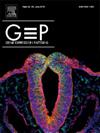Transcriptomics and phenotypic analysis of OTOF gene knockdown in zebrafish mediated by CRISPR/Cas9
IF 1.1
4区 生物学
Q4 DEVELOPMENTAL BIOLOGY
引用次数: 0
Abstract
Deafness is a common genetic disorder, where mutations,in the OTOF gene can disrupt the normal functionof the Otoferlin protein, leading to impaired neurotransmitter release in the inner ear and subsequent deafness. Despite the complexity of the pathogenic mechanism,it is not fully understood. Zebrafish are an excellent model for studying genetically-induced deafness,but there have been no previous reports on the pathogenesis of OTOF in zebrafish.This study successfully established a zebrafish model with mutated OTOF genes using CRISPR/Cas9 gene editing technology to investigate the molecular basis of OTOF-induced deafness. Compared to AB wild type zebrafish, those with low otof expression showed injury and apoptosis of hair cells in the posterior lateral neuromasts along with significant increase in the number of macrophages and apoptotic cells in this region. Additionally, these mutants exhibited a reduction in body length. To further elucidate differences at 5dpf (days post-fertilization) between mutant and wild type zebrafish embryos, RNA-seq analysis was conducted to examine differentially expressed genes (DEGs).A total of 334 up-regulated DEGs and 111 down-regulated DEGs were identified in mutants compared to wild types.KEGG and GO enrichment analyses were performed on these DEGs to identify key signaling pathways and hub DEGs. The findings revealedan increased expression of several genes involved in the HSP70 oxidative stress system, suggesting that OTOF may protect cochlear hair cell from apoptosis induced by oxidative stress through regulation of MAPK signal and HSP70 expression.In summary, the establishment of a zebrafish model with OTOF knockout provides a valuable tool for investigating the function of Otoferlin and understanding the role of the OTOF gene in deafness. These potential molecular insights offer significant contributions towards understanding the pathogenesis of deafness experimental models and serves as a foundation for comprehending the involvement of the OTOF gene.
CRISPR/Cas9介导的斑马鱼OTOF基因敲低的转录组学和表型分析
耳聋是一种常见的遗传性疾病,其中OTOF基因的突变可以破坏Otoferlin蛋白的正常功能,导致内耳神经递质释放受损,从而导致耳聋。尽管致病机制复杂,但尚未完全了解。斑马鱼是研究遗传性耳聋的良好模型,但目前还没有关于斑马鱼耳聋发病机制的报道。本研究利用CRISPR/Cas9基因编辑技术成功建立了OTOF基因突变的斑马鱼模型,探讨OTOF致耳聋的分子基础。与AB野生型斑马鱼相比,低表达斑马鱼后外侧神经突毛细胞损伤和凋亡,该区域巨噬细胞和凋亡细胞数量显著增加。此外,这些突变体表现出体长的减少。为了进一步阐明突变型和野生型斑马鱼胚胎在5dpf(受精后天数)的差异,采用RNA-seq分析来检测差异表达基因(DEGs)。与野生型相比,突变体中共鉴定出334个上调的deg和111个下调的deg。对这些deg进行了KEGG和GO富集分析,以确定关键信号通路和枢纽deg。研究结果显示,HSP70氧化应激系统中多个相关基因的表达增加,提示otoof可能通过调控MAPK信号和HSP70的表达,保护耳蜗毛细胞免受氧化应激诱导的凋亡。综上所述,建立OTOF基因敲除的斑马鱼模型,为研究Otoferlin的功能和了解OTOF基因在耳聋中的作用提供了有价值的工具。这些潜在的分子见解为理解耳聋的发病机制提供了重要的贡献,并为理解OTOF基因的参与奠定了基础。
本文章由计算机程序翻译,如有差异,请以英文原文为准。
求助全文
约1分钟内获得全文
求助全文
来源期刊

Gene Expression Patterns
生物-发育生物学
CiteScore
2.30
自引率
0.00%
发文量
42
审稿时长
35 days
期刊介绍:
Gene Expression Patterns is devoted to the rapid publication of high quality studies of gene expression in development. Studies using cell culture are also suitable if clearly relevant to development, e.g., analysis of key regulatory genes or of gene sets in the maintenance or differentiation of stem cells. Key areas of interest include:
-In-situ studies such as expression patterns of important or interesting genes at all levels, including transcription and protein expression
-Temporal studies of large gene sets during development
-Transgenic studies to study cell lineage in tissue formation
 求助内容:
求助内容: 应助结果提醒方式:
应助结果提醒方式:


